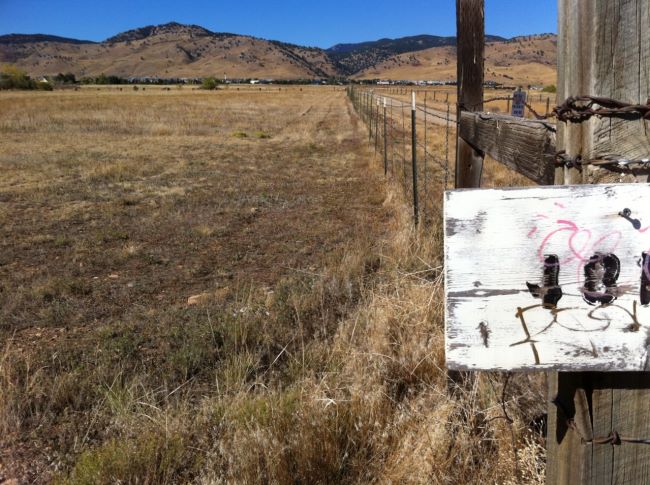The Boulder City Council may weaken the city’s growth management plan to permit development in the Area III Planning Reserve. The reserve contains about 500 acres and is located north of Jay Road and east of 28th Street (US 36) in north Boulder.
The Planning Reserve was established in the Boulder Valley Comprehensive Plan, a document adopted by the City of Boulder and Boulder County to regulate growth and establish land uses in the Boulder Valley. One of the keystones of the plan is to restrict sprawl by concentrating development within current City of Boulder boundaries. Under the current plan, 28th Street creates an edge to the city and limits development beyond.
The Planning Reserve was also designed to have a safety valve, allowing development only in the more distant future (fifteen years) or when a special community need for the land was identified. The Comprehensive Plan is only updated every five years and changes must be approved by the Boulder City Council, the Boulder County Commissioners, Boulder Planning Board and Boulder County Planning Commission, a process known as “four body review.”
A regular five year update occurs this year. Changes to the Comprehensive Plan can be considered, including requests by property owners to allow development in the Planning Reserve. Two such requests were made for the 2010 update, one for a large private sports training facility and another for a residential subdivision.
On October 12, the City Council held a special meeting to discuss the two projects and possible changes to the procedure by which development in the Planning Reserve can be allowed. The City’s planning staff recommended postponing consideration of the two development proposals until the entire Planning Reserve process could be reconsidered.
The staff made several suggestions about how the process could be improved, at least for property owners in the Planning Reserve if not the public. These included eliminating the “four body review” and taking the county out of the picture, allowing development proposals to be made at any time, and creating a procedure for determining what constitutes a “community need” that cannot be fulfilled within the current boundaries of the City of Boulder. Council unanimously acquiesced and instructed staff to prepare specific changes for consideration in 2011. Only Council member Lisa Morzel showed any skepticism about the need to weaken the process.
Supporters of changing the process called it “broken” but never offered any concrete evidence of why it must be weakened. Instead, Council is stampeding towards changing a process that has worked well since its inception in 1993. Boulder citizens might ask why there is a need for change now. What’s the rush?
It may well be appropriate in the future to allow development in the Planning Reserve, but that should be the result of a broad community consensus and an imaginative plan, not a hurried response to proposals from landowners.
From the perspective of the overall Boulder community several issues arise from staff’s recommendations and Council’s hasty approval:
- Property owners in the Planning Reserve are aware of current land use and growth management policies in the Boulder Valley Comprehensive Plan. Should the City of Boulder violate its own planning principles for individual benefit?
- Who decides the definition of “community need,” the planners and property owners or the public? Does development of a large sports training center and a subdivision meet a threshold that justifies sprawl across 28th Street into the Planning Reserve?
- If development occurs in the Planning Reserve who pays for necessary infrastructure improvements needed for the entire 500 acres? Will the property owners who benefit from development be required to pay for improvements to 28th Street, including sidewalks, curbs and gutters, landscaping, traffic signals, street lights, underground utility lines and bicycle lanes on the busy thoroughfare? How about RTD bus line extensions, parks and improved police and fire services? In other words, what’s in it for the people of Boulder? What is the public benefit?
- What impacts will residents of nearby neighborhoods experience? Will development in the Planning Reserve, especially the proposed large sports training facility, require widening of streets such as Broadway, Jay Road, Violet Avenue and Yarmouth Avenue?
- Will a conceptual plan be developed for the entire Planning Reserve or will development be allowed piecemeal? How will the public be involved? We certainly don’t want this important piece of land, a gateway to the city from the north, to be subjected to the types of mediocre planning that gave us the Transit Village Area Plan and the 29th Street shopping center.
The process by which these changes were considered was not well publicized. Before the City Council moves to weaken Boulder’s long-standing growth management policies there should be broad public involvement. Perhaps in the end the citizens of Boulder will support imaginative development of the Planning Reserve. However, we might also just as likely see great benefits accrue to property owners and developers and not to the community as a whole.
If you are concerned about Council’s moves to loosen the rules and facilitate development in the Planning Reserve let them know. They are, after all, elected to represent all of the people of Boulder.



